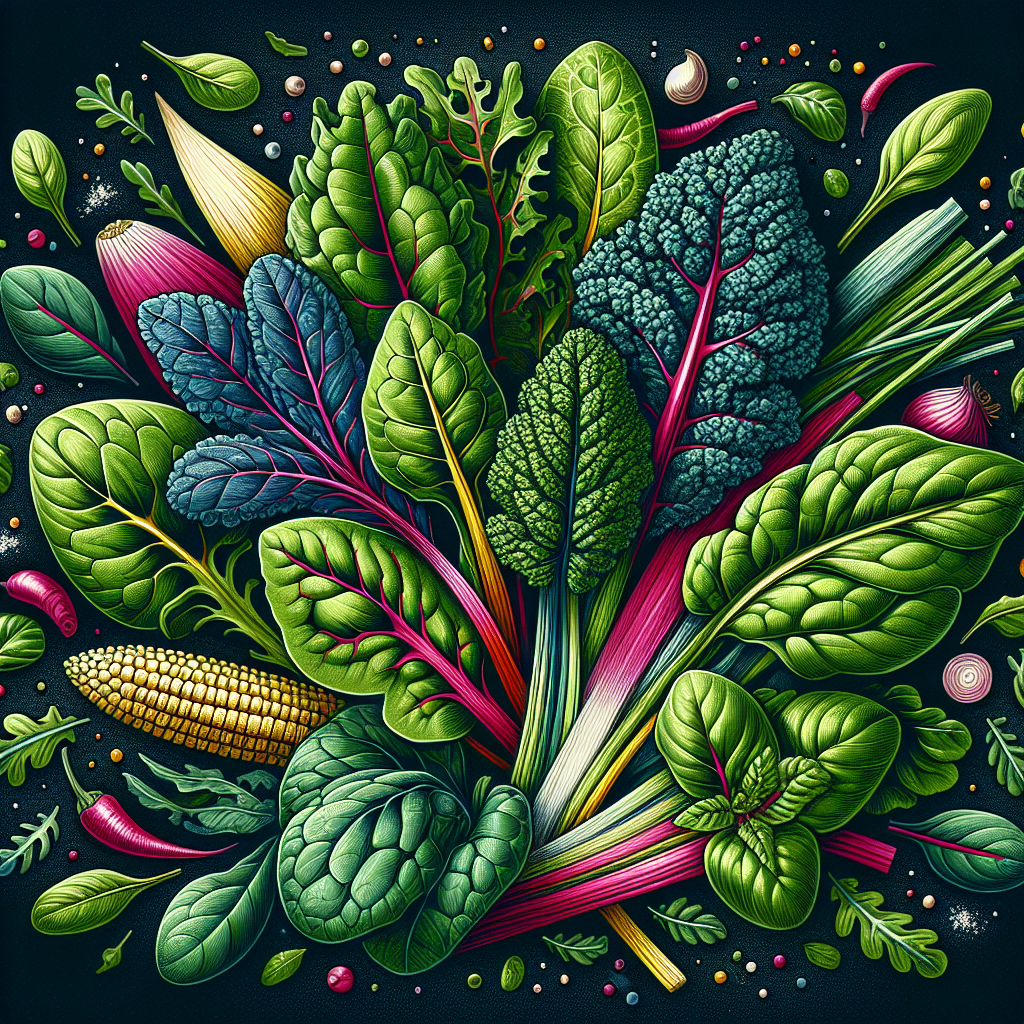Boost your health and vitality by harnessing the power of leafy greens. Packed with essential vitamins, minerals, and antioxidants, these nutritional powerhouses are a delicious and versatile addition to your diet. From kale and spinach to Swiss chard and arugula, these vibrant and flavorful greens offer a wide range of benefits, such as improved digestion, stronger immune function, and increased energy levels. Whether enjoyed in a salad, sautéed as a side dish, or blended into a refreshing smoothie, leafy greens are a simple yet effective way to prioritize your well-being and nourish your body with the goodness it deserves. So, why wait? Let’s explore the incredible world of leafy greens and unlock their limitless potential for a healthier, happier you.

Benefits of Leafy Greens
Leafy greens are not only delicious and versatile, but they also provide numerous health benefits. Incorporating them into your diet can have a positive impact on your overall well-being. Here are some of the key benefits of leafy greens that make them an essential part of a healthy lifestyle.
Packed with essential vitamins and minerals
Leafy greens are nature’s multivitamin. They are rich in essential vitamins and minerals that are crucial for maintaining optimal health. Varieties like spinach, kale, and Swiss chard are particularly abundant in vitamins A, C, and K. Vitamin A is essential for maintaining healthy vision, promoting immune function, and supporting cell growth. Vitamin C is well-known for its immune-boosting properties and its role in collagen production, while vitamin K plays a vital role in blood clotting and bone health.
High in antioxidants
Leafy greens are a powerhouse of antioxidants, which are compounds that help protect your body against oxidative stress and damage caused by harmful free radicals. Antioxidants help neutralize these free radicals and may reduce the risk of chronic diseases, such as heart disease and certain types of cancer. Leafy greens like spinach, kale, and arugula are particularly high in antioxidants like beta-carotene, lutein, and zeaxanthin.
Promote healthy digestion
If you’re looking to improve your digestive health, leafy greens should be your go-to. These greens are rich in dietary fiber, which promotes healthy digestion by adding bulk to your stool and preventing constipation. Fiber also acts as a prebiotic, providing nourishment for the beneficial bacteria in your gut. Greens like lettuce, collard greens, and cabbage are excellent sources of fiber, helping to maintain a healthy gut and prevent digestive issues.
Boost immune system
Leafy greens are a natural way to boost your immune system. They are packed with immune-boosting nutrients like vitamins A, C, and K, as well as antioxidants. These nutrients help strengthen your immune defenses, allowing your body to fight off infections and illnesses more effectively. Incorporating leafy greens into your diet can provide a natural defense against seasonal colds and flu.
Support heart health
Maintaining a healthy heart is crucial for overall well-being, and leafy greens can help you achieve that. These greens are low in calories and packed with nutrients like potassium, magnesium, and folate, which are known to support heart health. Potassium helps regulate blood pressure, while magnesium and folate play important roles in maintaining a healthy cardiovascular system. Moreover, leafy greens contain dietary nitrates, which have been shown to improve blood vessel function and promote healthy blood flow.
Different Types of Leafy Greens
Leafy greens come in various delicious and nutritious forms. Each type has its unique taste and texture, allowing you to experiment and find your favorites. Here are some popular options to consider:
Spinach
Spinach is a versatile leafy green that can be enjoyed raw or cooked. It has a mild flavor and tender leaves, making it perfect for salads, smoothies, and sautés. Spinach is an excellent source of vitamins A, C, and K, as well as iron and fiber.
Kale
Kale has gained a well-deserved reputation as a superfood. It has a slightly bitter taste and sturdy leaves, which make it suitable for a variety of dishes. Kale is packed with vitamins A, C, and K, along with minerals like calcium and magnesium. It is also a great source of antioxidants, including lutein and zeaxanthin.
Lettuce
Lettuce comes in several varieties, including romaine, iceberg, and leaf lettuce. It is known for its crisp texture and refreshing taste, making it a popular choice in salads and sandwiches. While lettuce is not as nutrient-dense as other leafy greens, it is still a good source of vitamins A and K, as well as folate and potassium.
Collard Greens
Collard greens have thick, dark green leaves and a slightly bitter taste. They are a staple in Southern cuisine and can be used in a variety of dishes, such as soups, stews, and stir-fries. Collard greens are rich in vitamins A, C, and K, as well as calcium and fiber.
Swiss Chard
Swiss chard is known for its vibrant rainbow-colored stems and dark green leaves. It has a slightly bitter taste and can be enjoyed raw or cooked. Swiss chard is an excellent source of vitamins A, C, and K, as well as magnesium and potassium.
Arugula
Arugula, also known as rocket, has a peppery and slightly bitter taste. It adds a flavorful kick to salads, pizzas, and sandwiches. Arugula is rich in vitamins A, C, and K, and contains beneficial compounds like glucosinolates, which have been associated with cancer prevention.
Mustard Greens
Mustard greens have a distinctive peppery flavor and tender leaves. They are commonly used in Southern and Asian cuisines and can be enjoyed sautéed, steamed, or added to soups. Mustard greens are a great source of vitamins A, C, and K, as well as folate and fiber.
Turnip Greens
Turnip greens have a slightly bitter taste and tender leaves. They are often used in hearty soups and stews, or sautéed as a side dish. Turnip greens are packed with vitamins A, C, and K, as well as calcium and potassium.
Beet Greens
Beet greens are the leafy tops of beetroot and have a slightly earthy taste. They can be enjoyed raw in salads or cooked as a side dish. Beet greens are rich in vitamins A, C, and K, as well as iron and fiber.
Cabbage
Cabbage comes in various types, including green, red, and Napa cabbage. It has a crunchy texture and a mild flavor, making it versatile in a range of dishes. Cabbage is an excellent source of vitamins C and K, as well as antioxidants like anthocyanins, which give red cabbage its vibrant color.

Nutritional Content of Leafy Greens
Leafy greens are not only delicious but also incredibly nutrient-dense. They provide a wide array of essential vitamins, minerals, and other beneficial compounds that contribute to overall health and well-being. Here is a closer look at the nutritional content of leafy greens:
Vitamins (A, C, K)
Leafy greens are an excellent source of vitamins A, C, and K. Vitamin A is important for maintaining healthy vision, immune function, and cell growth. It also plays a crucial role in promoting healthy skin and preventing age-related eye diseases. Vitamin C is known for its immune-boosting properties and its role in collagen production, which helps support healthy skin and joints. Vitamin K is essential for blood clotting and bone health.
Minerals (iron, calcium, magnesium)
Leafy greens are rich in minerals like iron, calcium, and magnesium. Iron is necessary for the production of red blood cells and oxygen transport throughout the body. Calcium is crucial for maintaining strong bones and teeth, while magnesium plays a role in hundreds of biochemical reactions in the body and supports nerve and muscle function.
Dietary fiber
Leafy greens are a great source of dietary fiber, which is important for maintaining a healthy digestive system. Fiber adds bulk to your stool, preventing constipation and promoting regular bowel movements. It also helps regulate blood sugar levels, reduce cholesterol levels, and promote a feeling of fullness, which can aid in weight management.
Plant-based protein
While leafy greens are not a significant source of protein compared to animal-based foods, they still contribute to your daily protein intake. Leafy greens contain plant-based proteins that are easily absorbed by the body and can help meet your protein needs, especially when combined with other protein-rich foods.
Phytochemicals
Leafy greens are rich in phytochemicals, which are natural compounds found in plants. These compounds have antioxidant, anti-inflammatory, and detoxifying properties, and may help reduce the risk of chronic diseases. Some examples of phytochemicals in leafy greens include beta-carotene, lutein, and zeaxanthin.
Leafy Greens for Detoxification
Detoxification is the process of eliminating toxins from the body, and leafy greens can play a significant role in supporting this natural process. Here’s why leafy greens are considered great detoxifiers:
Natural detoxifiers
Leafy greens are natural detoxifiers due to their high content of chlorophyll, a pigment responsible for their green color. Chlorophyll has been shown to help eliminate toxins, heavy metals, and environmental pollutants from the body. It can also support liver function, which is the primary organ responsible for detoxification.
Rich in chlorophyll
Chlorophyll is abundant in leafy greens and has numerous health benefits. It has been shown to help cleanse and alkalize the blood, promote healthy digestion, and even reduce body odor. Chlorophyll can also increase oxygen delivery to cells, which is essential for overall cellular health.
Support liver function
The liver is responsible for detoxifying harmful substances and filtering them out of the body. Leafy greens contain compounds that support liver function and enhance its ability to detoxify. These compounds can help protect the liver from damage and assist in the removal of toxins, keeping your liver healthy and functioning optimally.
Help eliminate toxins
Leafy greens are high in fiber, which helps promote regular bowel movements and eliminate waste and toxins from the body. Adequate fiber intake supports a healthy gut and prevents toxins from being reabsorbed into the bloodstream. Additionally, leafy greens contain antioxidants that help neutralize harmful free radicals and reduce oxidative stress, which can contribute to toxin accumulation.

Weight Management and Leafy Greens
Maintaining a healthy weight is essential for overall well-being, and leafy greens can be a valuable tool in achieving your weight management goals. Here’s how leafy greens can support your weight loss efforts:
Low in calories
Leafy greens are low in calories, making them a perfect addition to any weight loss or weight management plan. They provide a high volume of food for few calories, allowing you to fill up without consuming excess energy. This can help create a calorie deficit, which is necessary for weight loss.
High in fiber
Fiber is an important nutrient for weight management, as it promotes feelings of fullness and satiety, reducing the likelihood of overeating. Leafy greens are particularly high in fiber, which adds bulk to your meals and helps control hunger and cravings. Including leafy greens in your diet can help you feel satisfied while consuming fewer calories.
Promote satiety
Leafy greens contain specific compounds that stimulate the release of hormones responsible for promoting satiety. These hormones signal your brain that you’re full and satisfied, preventing overeating and aiding in weight management. Leafy greens are an excellent addition to meals for increasing satiety and reducing the tendency to snack on unhealthy foods.
Healthy option for weight loss
Leafy greens are nutrient-dense and can be used as a base for a variety of healthy meals. They can be incorporated into salads, stir-fries, or used as a replacement for starchy carbs like pasta or rice. By substituting calorie-dense foods with leafy greens, you can reduce your overall calorie intake and create a calorie deficit, which is essential for weight loss.
Leafy Greens for Skin Health
Having healthy and vibrant skin is a common goal, and leafy greens can contribute to achieving that. Here’s how leafy greens can help improve the health and appearance of your skin:
Vitamin C for collagen production
Leafy greens, such as kale and spinach, are rich in vitamin C, a crucial nutrient for collagen production. Collagen is a protein that provides structure to your skin, keeping it firm, smooth, and wrinkle-free. Vitamin C plays a key role in collagen synthesis and is essential for maintaining healthy skin. Regular consumption of vitamin C-rich leafy greens can support collagen production and contribute to youthful-looking skin.
Antioxidants for anti-aging effects
Leafy greens are packed with antioxidants, which help combat oxidative stress and protect your skin from premature aging. They neutralize harmful free radicals that can damage skin cells and contribute to the formation of wrinkles, fine lines, and age spots. Antioxidants like beta-carotene, lutein, and zeaxanthin found in leafy greens can promote skin health and give your complexion a healthy glow.
Hydrating properties
Proper hydration is essential for maintaining healthy skin, and leafy greens can contribute to your overall hydration status. Leafy greens have a high water content, which helps keep your skin moisturized and plump. Including leafy greens in your diet can provide a natural source of hydration, supporting your skin’s health and appearance.
Reduce inflammation
Inflammation is a common underlying factor in skin conditions like acne, eczema, and psoriasis. Leafy greens contain anti-inflammatory compounds that can help reduce inflammation in the body, including the skin. By incorporating leafy greens into your diet, you may experience a reduction in skin inflammation and an improvement in overall skin health.
Improving Bone Health with Leafy Greens
Maintaining strong and healthy bones is crucial for preventing conditions like osteoporosis and fractures. Leafy greens can play a beneficial role in supporting bone health. Here’s why incorporating leafy greens into your diet is essential for optimal bone health:
Calcium content
Leafy greens, such as kale and collard greens, are excellent sources of calcium, a mineral that is essential for bone health. Calcium is necessary for maintaining strong bones and teeth, and leafy greens can be a valuable source of this vital nutrient for those who follow a plant-based or dairy-free diet.
Vitamin K for bone strength
Leafy greens are a rich source of vitamin K, a nutrient that plays a critical role in bone metabolism. Vitamin K is necessary for the production of proteins that regulate calcium balance in bones and promote bone mineralization. By incorporating leafy greens into your diet, you can increase your intake of this bone-strengthening vitamin.
Prevention of osteoporosis
Osteoporosis is a condition characterized by weak and brittle bones, often associated with aging. Leafy greens can be an important preventive measure against osteoporosis due to their calcium and vitamin K content. Consuming an adequate amount of leafy greens can help maintain bone density and reduce the risk of fractures as you age.
Leafy Greens and Eye Health
Protecting your vision and maintaining eye health is crucial as you age. Leafy greens can contribute to optimal eye health due to their nutrient content. Here’s how leafy greens can benefit your eyes:
High in beta-carotene
Leafy greens like spinach and kale are rich in beta-carotene, a precursor to vitamin A. Beta-carotene is essential for maintaining healthy vision and preventing age-related macular degeneration. It acts as an antioxidant, protecting your eyes from oxidative stress and damage caused by free radicals.
Protect against macular degeneration
Macular degeneration is a leading cause of vision loss and is often associated with aging. Leafy greens, especially those rich in lutein and zeaxanthin, can help protect against macular degeneration. These antioxidants accumulate in the macula, the central part of the retina responsible for sharp and detailed vision, and help filter harmful blue light and reduce oxidative damage.
Maintain healthy vision
Leafy greens contain vitamins A and C, which are crucial for maintaining healthy vision. Vitamin A helps protect the surface of the eye and supports the retina’s ability to absorb light. Vitamin C is an antioxidant that helps maintain blood vessels in the eyes and prevent damage from free radicals. By incorporating leafy greens into your diet, you can provide your eyes with the essential nutrients they need to stay healthy.
Incorporating Leafy Greens into Your Diet
Now that you’re aware of the incredible benefits of leafy greens, you may wonder how to incorporate them into your diet. Fortunately, there are numerous delicious and creative ways to enjoy leafy greens. Here are some suggestions:
Fresh salads
One of the easiest and most popular ways to enjoy leafy greens is in a fresh salad. Start with a base of your favorite leafy greens, such as spinach or mixed baby greens, and add a variety of colorful vegetables, fruits, nuts, seeds, and a healthy dressing. Get creative with your salad ingredients to make a satisfying and nutritious meal.
Smoothies and green juices
Smoothies and green juices are an excellent way to pack a variety of leafy greens into a single meal. Combine leafy greens like kale or spinach with fruits, plant-based milk or yogurt, and a source of protein like nut butter or protein powder. Blend until smooth, and enjoy a refreshing and nutrient-packed beverage.
Stir-fries and sautés
Leafy greens can be quickly and easily incorporated into stir-fries and sautés. Simply add a handful of washed and chopped leafy greens, such as bok choy or Swiss chard, to your favorite stir-fry or sautéed vegetable recipe. Cook until wilted, and enjoy the added nutritional boost.
Incorporating into soups and stews
Leafy greens can add a fresh and nutritious element to soups and stews. Add a handful of greens like collard greens or cabbage to your favorite soup or stew recipe. They will add flavor, color, and a wealth of vitamins and minerals to your bowl.
Roasting or grilling
Roasting or grilling leafy greens can provide a unique twist to your meals. Try roasting kale leaves until crispy for a healthy and flavorful snack. Grilling romaine lettuce can add a smoky and charred flavor to your salads. Get creative and experiment with different cooking methods to discover new favorite ways to enjoy leafy greens.
Precautions and Tips
While leafy greens offer numerous health benefits, it’s essential to follow a few precautions and tips for their optimal consumption. Here’s what to keep in mind:
Washing leafy greens properly
Before consuming leafy greens, ensure they are thoroughly washed to remove any dirt, bacteria, or pesticide residues. Wash them under cold running water and gently rub the leaves with your hands. Consider using a produce wash or vinegar solution for an extra cleanse. Pat them dry or use a salad spinner before consuming or storing.
Cooking methods for maximum nutrition
While raw consumption of leafy greens provides maximum nutritional benefits, some cooking methods can help enhance nutrient absorption. Lightly steaming or sautéing leafy greens can make certain nutrients more bioavailable, such as beta-carotene in spinach. However, avoid overcooking, as excessive heat can destroy heat-sensitive vitamins.
Balancing variety in your diet
While leafy greens are highly nutritious, it’s important to maintain a balanced and varied diet. Incorporate a variety of vegetables, fruits, whole grains, and lean proteins to ensure you’re getting a wide range of nutrients. Rotate different types of leafy greens to diversify your nutrient intake and avoid potential nutrient imbalances.
Avoiding excessive consumption
While leafy greens are generally safe for consumption, excessive intake can lead to certain complications. For individuals taking blood-thinning medications like warfarin, it’s important to consult with a healthcare professional about intake since leafy greens can interfere with medication effectiveness. Additionally, those with specific medical conditions like kidney stones should discuss their leafy green consumption with their healthcare provider.
Choosing organic options
Leafy greens, like other produce, can contain pesticide residues. Choosing organic options when possible can reduce exposure to harmful chemicals. If organic leafy greens are not available or affordable, ensure thorough washing to minimize any potential pesticide residues.
Incorporating leafy greens into your diet can be a game-changer in terms of your overall health and well-being. From promoting healthy digestion and boosting your immune system to improving skin health and supporting bone strength, leafy greens offer a wide range of benefits. Get creative in the kitchen and explore various ways to enjoy these nutritional powerhouses, and remember to prioritize a balanced and varied diet to reap the full rewards of leafy greens. Prioritize your well-being by including leafy greens in your meals, and discover the transformative impact they can have on your health.

